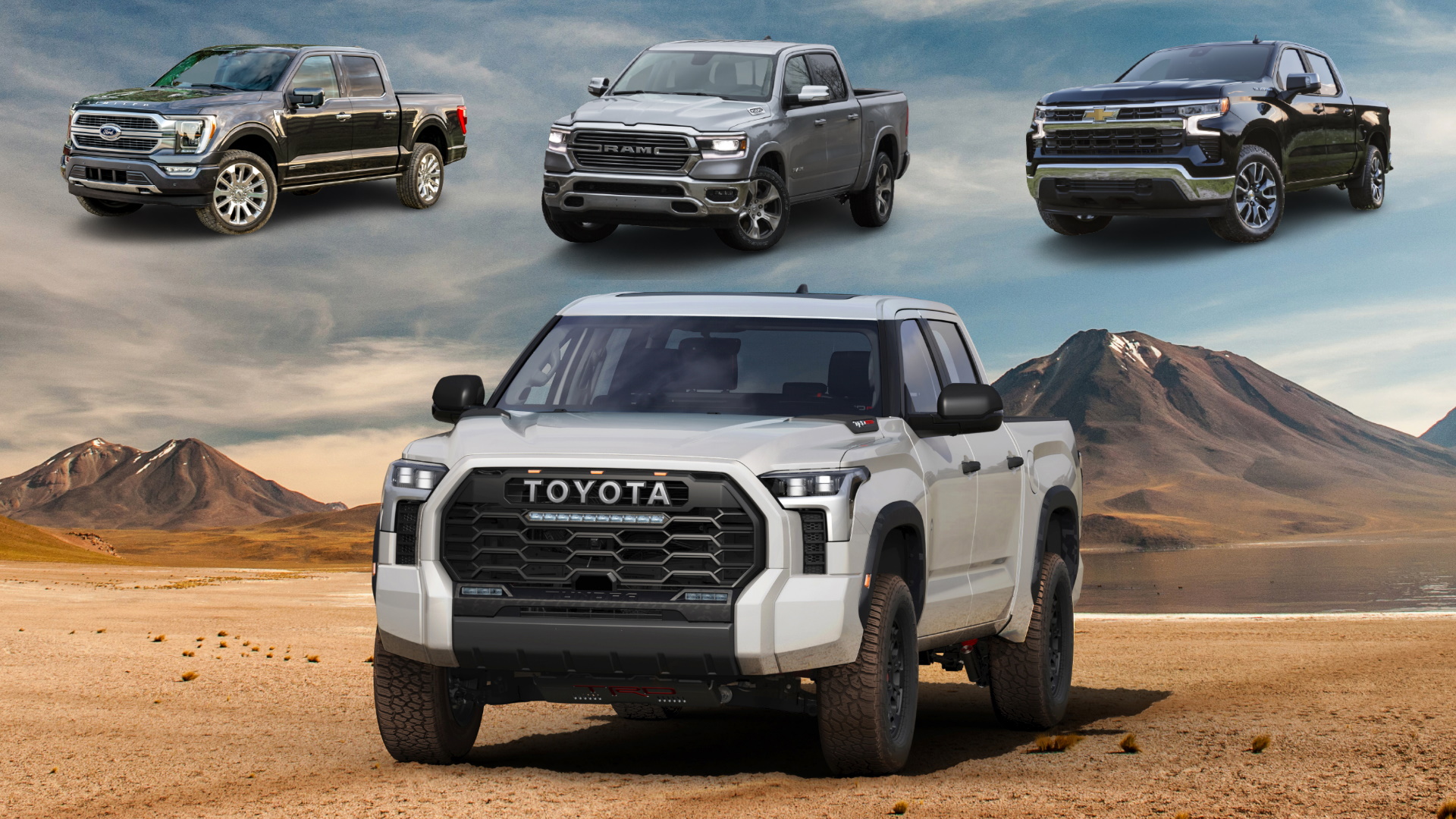

The Toyota Tundra has never commanded the same colossal sales figures as the Ford F-150,
Ram 1500, or Chevy Silverado. There’s a brand-new one for 2022, though, and Toyota has made a slew of changes to the truck to try and make it more competitive against the Big Three’s best. The question is: Is it enough?
Well, below you’ll find some of the most important specs of the most capable trims and engine configurations for each vehicle, all in the same place. Let’s see how this new Toyota does.

2022 Toyota Tundra
- Engine | Power: 3.5-liter i-Force Max twin-turbo V6 hybrid | 437 horsepower and 583 pound-feet of torque
- Max Towing: 12,000 pounds
- Max Payload: 1,940 pounds
2021 Ford F-150
- Engine | Power: 3.5-liter PowerBoost twin-turbo V6 hybrid | 430 hp and 570 lb-ft of torque
- Max Towing: 14,000 pounds
- Max Payload: 3,325 pounds
2022 Chevy Silverado 1500
- Engine | Power: 6.2-liter V8 | 420 hp and 460 lb-ft of torque
- Max Towing: 13,300 pounds
- Max Payload: 2,280 pounds
2021 Dodge Ram 1500
- Engine | Power: 5.7-liter V8 with 48-volt eTorque mild-hybrid | 395 hp and 410 lb-ft of torque
- Max Towing: 12,750 pounds
- Max Payload: 2,300 pounds
Before you compare any pickups head-to-head, you have to know which configurations you’re pitting against one another—it can be almost overwhelming. There are so many bed lengths, cab layouts, tow packages, and drivetrain combinations, and all of these affect the truck’s capabilities. For the sake of superlatives, we’ve listed each truck’s max in terms of power, towing capacity, and payload rating, though each is achieved in various engine, cab and bed configurations.



The Tundra’s towing capacity is up by a full ton for 2022, though it’s still beaten by the domestic trucks. The Ram 1500’s max tow rating is 12,750 pounds, and to hit that number, it’ll have to be in an extended cab 4×2. Meanwhile, an extended cab Chevy Silverado 1500 4×4 can drag 13,300 pounds with either the 6.2-liter gas V8 or its 3.0-liter Duramax diesel inline-six. Finally, a 4×2 Ford F-150 can pull a class-leading 14,000 pounds when spec’d properly, though it’s actually the less powerful, non-hybrid 3.5-liter EcoBoost that does the job in this case.
In terms of payload, the Toyota is also at the bottom of this comparison. The Ram 1500’s max payload is 2,300 pounds, though to get that, you’ll need a 3.6-liter V6 truck with the 3.55 rear axle. Meanwhile, a regular cab F-150 4×2 with the V8 can bear 3,325 pounds in the bed. Finally, the 2022 Chevy Silverado can carry 2,280 pounds in its box. It’s important to note that these numbers are all closer when comparing specific cab, bed, and drivetrain configurations, but since you can’t get a regular cab Tundra, for example, it’s limited to the extended cab and crew cab’s ratings. The Tundra’s max tow and payload figures are achieved with an SR5, double cab, 6.5-foot-bed 4×2.

One area where the Tundra beats the competition is standard and available horsepower and torque. The V8 is gone for this generation of Tundra, but a powerful twin-turbo V6—similar on paper to Ford’s 3.5-liter EcoBoost—is now the base engine. All of the domestic trucks are also available as stripped-out work vehicles with lower power outputs, though that’s not the case with the Tundra; it can’t be had with anything less than 389 horsepower and 479 pound-feet of torque. The available hybridized version of this drivetrain is also impressive with best-in-class ratings of 437 hp and 583 pound-feet of torque.
It’s still to be seen if the Toyota’s interior and exterior styling will be well-received alongside vehicles like the recently refreshed Silverado. The Big Three and Toyota are all suffering from chip-related production stoppages and cutbacks, too, so the upper hand will be given to anyone who can actually put trucks on dealer lots and into customers’ hands. Until the semiconductor shortage wanes—and it may be a while before it does—it could be hard to see which one Americans like the best.
Got a tip or question for the author? You can reach them here: peter@thedrive.com